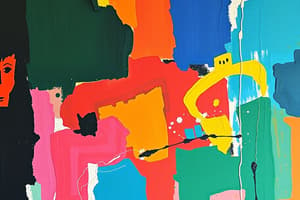Podcast
Questions and Answers
What role did artists like Leonardo da Vinci, Raphael, and Michelangelo play during the Renaissance?
What role did artists like Leonardo da Vinci, Raphael, and Michelangelo play during the Renaissance?
- They were responsible for spreading Renaissance ideals.
- They refined painting and sculpture techniques. (correct)
- They invented the printing press.
- They focused on politics and astronomy.
Which invention during the mid-15th century facilitated the rapid dissemination of knowledge and ideas?
Which invention during the mid-15th century facilitated the rapid dissemination of knowledge and ideas?
- The steam engine
- The compass
- The printing press (correct)
- The telescope
What was a key aspect of the Scientific Revolution that followed the Renaissance?
What was a key aspect of the Scientific Revolution that followed the Renaissance?
- Focus on artistic expression
- Promotion of traditional beliefs
- Importance of experimentation and observation (correct)
- Isolation from other cultures
What was a common emphasis shared by the French, German, and Dutch Renaissances?
What was a common emphasis shared by the French, German, and Dutch Renaissances?
In which period did the Renaissance spread throughout Europe?
In which period did the Renaissance spread throughout Europe?
What are some enduring values associated with the Renaissance?
What are some enduring values associated with the Renaissance?
What is the main philosophy celebrated during the Renaissance period?
What is the main philosophy celebrated during the Renaissance period?
Which region is credited with being the birthplace of the Renaissance?
Which region is credited with being the birthplace of the Renaissance?
What marked a significant departure in the visual arts during the Renaissance?
What marked a significant departure in the visual arts during the Renaissance?
Which scholars were instrumental in promoting humanist philosophy during the Renaissance?
Which scholars were instrumental in promoting humanist philosophy during the Renaissance?
What aspect of education was encouraged during the Renaissance period?
What aspect of education was encouraged during the Renaissance period?
What was a key feature of Italian city-states during the Renaissance?
What was a key feature of Italian city-states during the Renaissance?
Flashcards are hidden until you start studying
Study Notes
Renaissance: A Blossoming of Knowledge and Art
As we journey through history, the Renaissance stands as a beacon of innovation, enlightenment, and creative resurgence. This period of remarkable transformation, spanning approximately from the 14th to the 17th century, reverberates through the annals of history, leaving an indelible imprint on our understanding of art, humanism, and science.
Origins and Ideology
The Renaissance, often referred to as the "rebirth," originated in Italy, a region that had experienced a prolonged period of economic and political instability. As Italian city-states regained their stability, they fostered a cultural climate that fostered curiosity, critical thinking, and a newfound respect for ancient Greek and Roman ideals. The humanist philosophy, spearheaded by scholars like Leonardo Bruni and Poggio Bracciolini, celebrated the human spirit, emphasizing the intrinsic value and potential of the individual. This approach to learning encouraged an interdisciplinary approach to education, marked by the study of the humanities, natural sciences, and classical languages.
Artistic Achievements
The visual arts of the Renaissance, fueled by the humanist philosophy, saw tremendous progress. Painters, sculptors, and architects shattered the limitations of medieval art, embracing realism, perspective, and anatomical accuracy. Artists like Leonardo da Vinci, Raphael, and Michelangelo refined the techniques of painting and sculpture, producing masterpieces that continue to inspire and captivate audiences across the globe.
The Renaissance also brought about a rise in the practice of printing. Johannes Gutenberg's invention of the printing press in the mid-15th century facilitated the rapid dissemination of knowledge and ideas, accelerating the spread of new technologies and philosophies. Printed books were no longer reserved for the wealthy elite, but rather became accessible to people of all social classes.
The Scientific Revolution
The Renaissance also served as a catalyst for the Scientific Revolution, a period of significant advancement in the sciences. Notable figures such as Niccolò Machiavelli, Galileo Galilei, and Johannes Kepler expanded our understanding of the natural world, making groundbreaking contributions in the fields of politics, astronomy, and mathematics, respectively. The Scientific Revolution also emphasized the importance of experimentation and observation, enabling innovative discoveries that challenged traditional beliefs.
The Spread of the Renaissance
As the Renaissance gained momentum in Italy, it gradually spread throughout Europe. The French, German, and Dutch Renaissances, while distinct in their own right, shared a common emphasis on humanism and scientific inquiry. The exchange of ideas, cultural artifacts, and people across Europe drove the spread of Renaissance ideals, fostering an environment of intellectual curiosity and creative exploration that has endured for centuries.
In conclusion, the Renaissance represents a period of remarkable innovation, enlightenment, and creative resurgence. The humanist philosophy, artistic achievements, and scientific advancements of this epoch continue to shape our understanding of the world and the human condition. By examining the legacy of the Renaissance, we gain newfound appreciation for the enduring value of curiosity, critical thinking, and a respect for the human spirit.
Studying That Suits You
Use AI to generate personalized quizzes and flashcards to suit your learning preferences.




